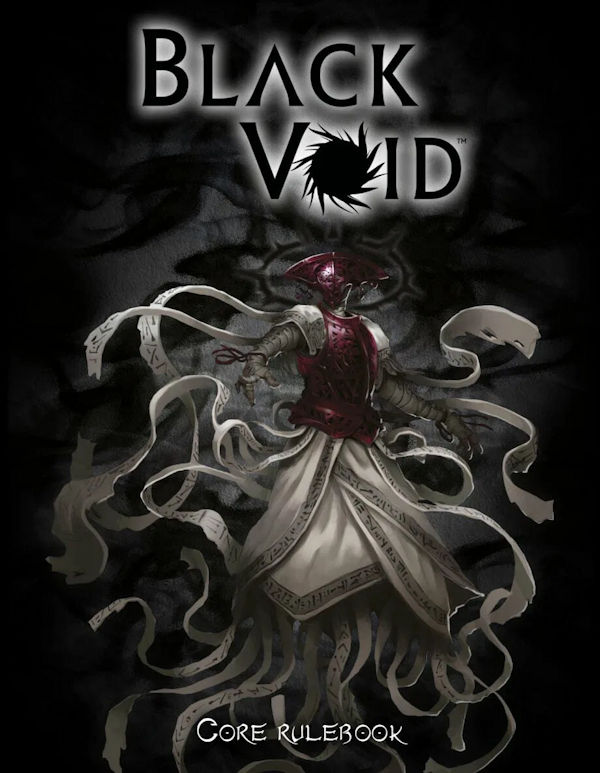 Black Void describes itself as an esoteric RPG. That might set veteran roleplayers to thinking about Unknown Armies or Kult—games set in our world which explore occult symbolism and themes. A better comparison would be Call of Cthulhu by way of Conan the Barbarian and Stargate. Though even that description misses out the Arabian Nights angle.
Black Void describes itself as an esoteric RPG. That might set veteran roleplayers to thinking about Unknown Armies or Kult—games set in our world which explore occult symbolism and themes. A better comparison would be Call of Cthulhu by way of Conan the Barbarian and Stargate. Though even that description misses out the Arabian Nights angle.
Black Void starts with the end of the world. Specifically, Earth during the heyday of ancient Mesopotamia. Clouds of swirling darkness tear the sky apart and all of humanity is devoured by a cosmic event beyond their understanding. The stories of Black Void centre around picking up the pieces of that disaster. Not on Earth, which has disappeared, but out in the wider Cosmos.
Not all of the humans devoured by the Void were killed or lost forever. Some were deposited on distant worlds and now seek to build a future for themselves in scattered and fragile enclaves. One such world is Llyhn the Eternal. A city that lies along a fault line between the known universe (the Cosmos) and the seething chaos of the Void. It’s a melting pot of alien cultures and a hub of trade and diplomatic negotiations.
Several disparate groups of humans have made their homes in Llyhn. They’re at the bottom of a cruel caste system where might makes right and weakness is despised. But they offer a small amount of protection and even hope to their members.
Llyhn is an exceedingly outlandish and hierarchical society where punishment is harsh for those who dare challenge the status quo without the means and method to succeed.
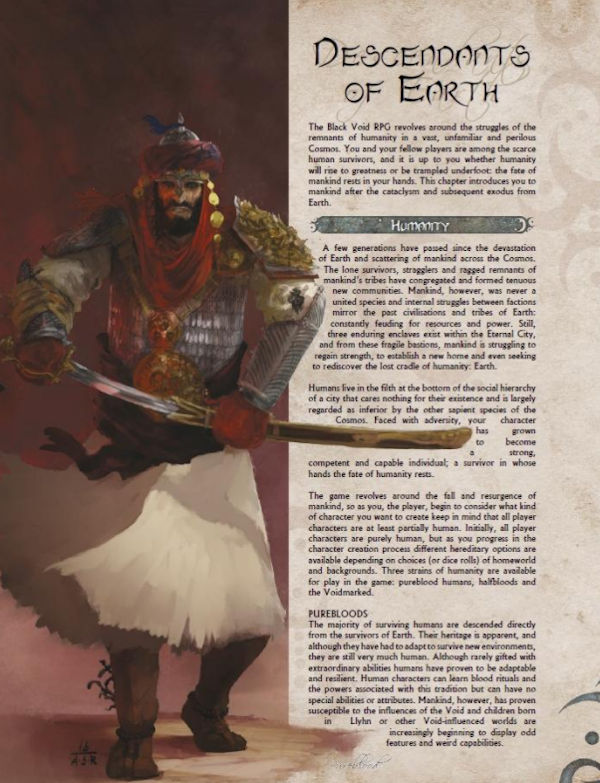 Player Characters (PCs) are descendants of humankind who seek to make their own way in the Cosmos and perhaps even forge a new destiny for humanity amongst the stars. Their adventures could centre entirely around Llyhn itself, span the Cosmos or take place on a completely different world.
Player Characters (PCs) are descendants of humankind who seek to make their own way in the Cosmos and perhaps even forge a new destiny for humanity amongst the stars. Their adventures could centre entirely around Llyhn itself, span the Cosmos or take place on a completely different world.
Before we go any further, let’s make one thing clear. This is not a sci-fi setting. It has some of the trappings of sci-fi but don’t be confused by the references to aliens, different worlds and interstellar travel. The tech level of all the major cultures in Black Void are pre-industrial and pre-gunpowder. There are a few different metals and other weird substances thrown into the mix and probably some shipbuilding or construction techniques that would have amazed an ancient Babylonian. But Star Wars this ain’t.
Void ships are literal sailing ships that pass through rifts in space, travel the maddening sea of the Void (which, while airless, somehow supports life without the need to breathe), and emerge on other worlds. It’s difficult and dangerous. Looking out of a window is an invitation to insanity. Horrible, half-formed things may descend on the ship and eat everyone on board. But it works well enough that certain races have formed entire inter-stellar empires and trade between worlds is common.
With the setting established, the book moves into the basics of the system and how to use it.
We get the usual helpful starting advice. The writers take pains to explain everything and the result should be fairly accessible for newcomers to the hobby. Moving into the actual rules, Black Void sets out its stall very early on—it’s based on simple, flexible rules that can simulate almost any situation without changing the core principle. The core principle being you try to match or beat a target number by rolling a D12 and adding any appropriate bonuses.
(I’ll note that, as the book goes on, it proceeds to surround its stall with an ever-expanding collection of tables. Tables for injuries, for fear, for delirium, for failure, for madness, for magical failures, for mutations and so on. It’s best to assume that any section of the book which details mechanics will have at least one table. Old school gamers should have a great time with this, your mileage may vary. It does lead to a bit of page-flipping to find the right table, but you should get plenty of variety out of play.)
Character Creation
Character creation uses a Point Buy system that lets you build your character from the ground up. It’s not entirely freeform though. For example, to create a standard starting character you need to spend half your points on Traits like Agility, Persuasion and Intellect and half on everything else—Backgrounds, Skills, Powers, Talents and Attributes.
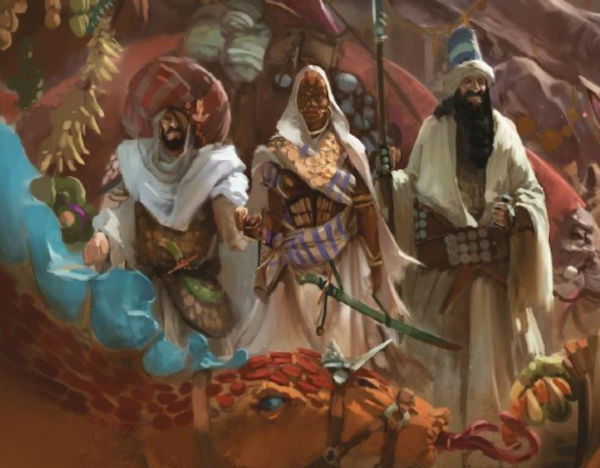
You also have to make a number of decisions that aren’t directly to do with the spending of your points. Is your character from Llyhn or another world? How civilised was this other world? How influenced was it by the warping influence of the Void? Each answer gives you different roleplaying tips and a free Talent or other benefit to represent the character’s upbringing. You also have to decide whether you’re a vanilla human, a hybrid of human and one or more alien species, or a human who has been mutated by the Void.
Hybrids can purchase Attributes, which in Black Void are things like wings, extra limbs, extra eyes, fangs, claws, tusks, extra senses, chitinous armour or the ability to breathe underwater. You could make someone who looks human but can echolocate. Or you could make a scuttling arachnoid nightmare who can climb, bite and claw things but struggles in social situations. Other humans may be less inclined to trust hybrids but the rest of Llyhn society may be more accepting of them, since they bear less resemblance to those pathetic human weaklings.
Void-touched characters can purchase Esoteric Attributes like shapeshifting, limited mind-control, supernatural presence, or extra heads. It’s a shorter list than the Attributes but very fun. Void-touched probably aren’t trusted by anyone, but who cares when you can shapeshift or hypnotise people?
Ordinary humans don’t get any particular compensation for lacking these powers as far as I can tell. Though the points system means they’ll have more points to spend on Skills, Powers and Talents than e.g. a Hybrid with armoured skin and wings would. Humans trust ‘pure’ humans more than the other two types but most everyone else will treat them like they’ve just scraped them off a shoe, so that’s not necessarily a good trade-off. (But then, I never did understand people who choose to play humans when any other option is on the table.)
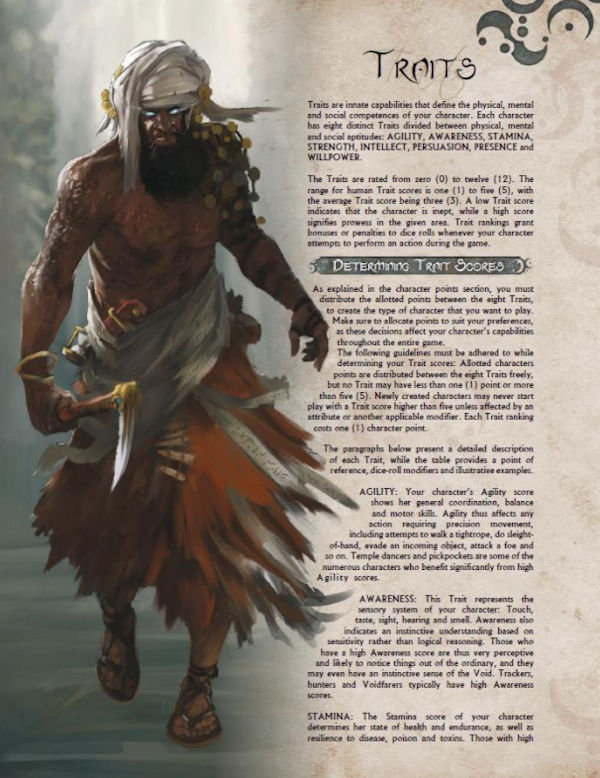 Traits are what many other games would call characteristics or stats—the raw physical, mental and social abilities of the character. Agility, Intellect, Persuasion, Stamina and so on. Low Traits give penalties to applicable rolls, higher ones grant bonuses, much like in D&D. Skills are far more specific than Traits but each rank in a Skill adds +1 to appropriate rolls. Aside from Combat Skills there are 25 Skills to choose from, including Commerce, Streetwise, Acrobatics, Intrigue, Larceny, Observation, Rituals and Socialise. The list reflects the kind of stories Black Void is intended to tell—characters living by their wits, stealing, lying or bartering on the streets of the Eternal City as they try to get ahead. There’s no particular need to have characters or parties who are focused on combat, you could just as easily politic your way through a perfumed court or carry out heists for a thief-king.
Traits are what many other games would call characteristics or stats—the raw physical, mental and social abilities of the character. Agility, Intellect, Persuasion, Stamina and so on. Low Traits give penalties to applicable rolls, higher ones grant bonuses, much like in D&D. Skills are far more specific than Traits but each rank in a Skill adds +1 to appropriate rolls. Aside from Combat Skills there are 25 Skills to choose from, including Commerce, Streetwise, Acrobatics, Intrigue, Larceny, Observation, Rituals and Socialise. The list reflects the kind of stories Black Void is intended to tell—characters living by their wits, stealing, lying or bartering on the streets of the Eternal City as they try to get ahead. There’s no particular need to have characters or parties who are focused on combat, you could just as easily politic your way through a perfumed court or carry out heists for a thief-king.
High levels in a particular Skill allow characters to purchase Specialisations, which offer a bonus to even more specific tasks like tightrope walking, inventing your own language or giving someone the silent treatment. A nice way to make a character even more unique.
Talents are extra bonus abilities which you can purchase if you have a high enough ranking in the appropriate Trait. These Talents have fairly broad applications and are fairly balanced. Some Talents are quite subtle, such as Thespian which allows a character to assume another identity every time they meet a new person. Others, like Ambidexterity or Brawny, have very clear and tangible in-game effects. I liked the way Talents help to define the character by describing their rippling muscles or eloquent nature. Looking through I could see how some Talents based on different Traits could work together to make a character specialised in a certain task, for example bonuses for Brawny and Imposing would stack to make a character especially good at intimidation.
Flaws are the opposite of Talents but also help to define a character. If a particular Trait is too low then the player can pick a Flaw such as Primitive, Emaciated or Repulsive Habits. The player gets extra points to spend at character creation in return for this but is expected to roleplay their character’s Flaws during the game.
Combat Skill Specialisations add another layer of possibilities. If you have a high enough score in a particular Combat Skill you can buy one of these special abilities. Assassinate, Dirty Fighting, Sidestep, Blade Wall, Precise Shot—you get the idea. One ability even lets you base your combat rolls on Intellect instead of on more physical Traits, which I appreciate.
Black Void is a game where you could find one niche and burrow into it, finding more and more complexity as you go. You could easily run a swashbuckling duellist character and have just as much depth to your abilities as a spellcasting character would.
Backgrounds in Black Void will be familiar to anyone who has played any Storyteller or Storypath games—Mentor, Follower, Status, Contacts and so on. This is also where you purchase status as a Hybrid or Void-Touched character. You’ll also need to calculate Health and Sanity. Which is where the resemblance to Call of Cthulhu comes in. This isn’t just a game of cosmic fantasy, there’s some cosmic horror to go along with it and it’s quite possible for your character to end their career as a gibbering wreck rather than a corpse.
There’s an element of randomness in determining Health, which I dislike. Considering this is a Point Buy system I see no reason to lose faith with the True Way and descend into the heresy of random stat generation right at the end.
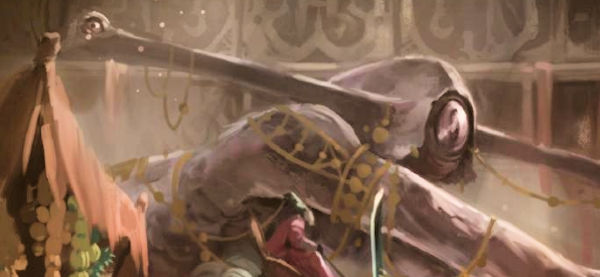
Finally, there’s some fairly involved and detailed advice on fleshing out your character. It’s clear from this chapter alone a huge amount of thought has gone into this book. This chapter also introduces two concepts which are tied into roleplaying and character background rather than character points.
Wastah is named after an actual Arabic word which roughly translates as connections, clout, nepotism and the ability to get your way through knowing people. In game, it’s an informal measure of social respect and deference amongst a specific group which can transcend caste. A character can have Wastah with a particular group and use it to get preferential treatment or call in favours. Its inclusion heightens the important of social skills and intrigue to the setting.
The other concept, Enlightenment, isn’t as close to the meaning of its real-world counterpart. Enlightenment in Black Void is a character’s knowledge or familiarity with the Void. Gaining Enlightenment grants all kinds of powers, from shapeshifting to the ability to inspire Awe (with a capital A), to the much-prized ability to navigate the currents of the Void.
Equipment
This chapter is where this game about magical space-travel, aliens, mutants, demons and blood magic settles down to brass tacks and becomes almost mundane for a while. The writers of Black Void clearly expect trading, working and moneymaking to be important parts of the game.
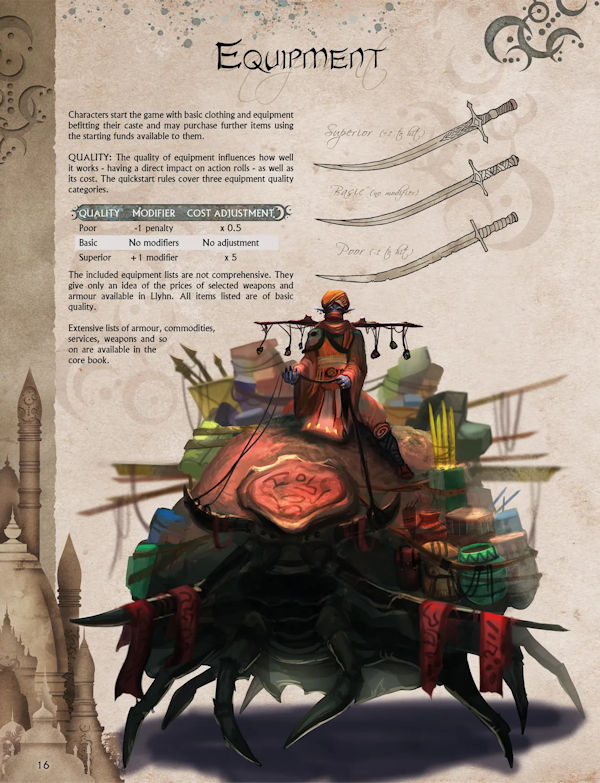 There are prices and descriptions of palanquins, saddle bags, wineskins, incense, bone saws, clay tablets, quills and multiple types of boats, amongst many other items. I think this is partly because the writers imagine player characters having a hardscrabble existence and expect them to pay for every useful item and take nothing for granted. But also, because the writers of this book clearly thought everything through very carefully before committing it to paper.
There are prices and descriptions of palanquins, saddle bags, wineskins, incense, bone saws, clay tablets, quills and multiple types of boats, amongst many other items. I think this is partly because the writers imagine player characters having a hardscrabble existence and expect them to pay for every useful item and take nothing for granted. But also, because the writers of this book clearly thought everything through very carefully before committing it to paper.
Again, there is an emphasis on activities besides combat. Purchasable items include make-up, incense for rituals and prayer beads, which add a bonus to meditation rolls. More adventuresome items include some quite distinctive non-magical healing salves that are less powerful than the classic D&D Healing Potion but rather more flavourful. The poisons are also interesting, great for when you want to ruin someone’s day. A standout is the small but intriguing section of riding animals and beasts of burden. Forget horses. Ride a giant beetle or a blue, spiky night-zebra into battle! I also enjoyed the handful of descriptions of more esoteric items like exploding pearls, feathery fur, blood iron and musical rocks.
MOHK PEARL: These rare pearls are found only on Na’ash, the homeworld of the Naqastï. They are delicately harvested from odd barnacles growing in remote canyons and are notoriously unstable, exploding on impact if jolted or bumped.
I’ll admit that my favourite section was tea. Tea is an important part of Llyhn’s culture, and the book presents several different varieties—alertness tea, healing tea, pain numbing tea. Brilliant stuff, more games should emphasise the importance of tea!
On the down side, did the game really need to tell you how much it costs to buy slaves? Including pleasure slaves? The book will note that pleasure slaves are entertainers—singers, dancers and conversationalists, rather than courtesans, who are a separate class. I understand the writers were leaning heavily into the vibe of ancient Mesopotamia. And the rest of the book seems to imply player characters are more likely to be rescuing slaves than trading in them. But still, yuck.
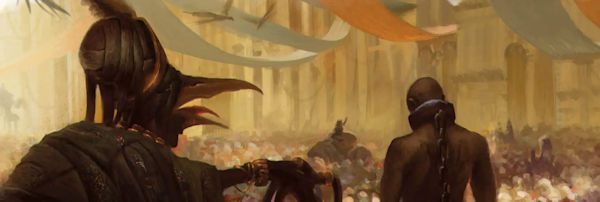
Moving on to weapons, we see just because you don’t have to fight in Black Void, doesn’t mean you can’t. The writers approach this section with their usual careful thoughtfulness. The weapons list is fairly complete but fairly standard for a fantasy RPG. The difference is in the weapon customisation options. You can give your sword a fullered, wave-pattern or hawkbill blade or make it lighter or heavier. Other fun options include adding spikes, weight or length to your preferred weapon. I really liked the options on offer here and the ability to make a unique weapon. (I did baulk at the two-pointed sword/spear which is better at piercing armour though. That’s not how physics work.)
Rules
This chapter is all about expanding on the core principles described in the introduction, applying them to more specific circumstances and propping them up with more tables. It covers what happens when characters work together or oppose each other or when something can’t be solved with a single roll e.g. a long crafting project or a chase. Also, different types of movement such as flying and swimming and, of course, combat. There’s even a table for calculating movement speed based on size and how many legs you walk on, which I didn’t really get my head around.
Most of it is fairly logical and intuitive though. For example, if a character tries to hypnotise another character, the target’s Willpower bonus is added to the difficulty of the attacker’s roll, no need for extra rolls or separate mechanics. We also get rules and random tables for Awe (the effects of supernatural charisma), Fear, Delirium (usually caused by drug use), Madness, Exceptional Hits, Injuries and Combat Mishaps. I liked the Fear table in particular as there’s a huge range of effects that aren’t limited to simply running away.
Combat itself follows the main rule set. I’ve mentioned already that combat-focused characters get plenty to work with in this game. There’s a whole raft of combat manoeuvres for such bloodthirsty types to get their teeth into. Including but not limited to—knockdowns, swift attacks, swarming attacks, feints and even a wild swing which lets a character attack two targets at once at the cost of a hefty penalty to their roll.
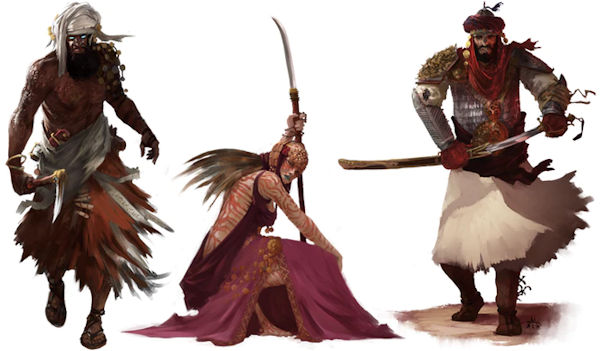
The Exceptional Hit table is especially long and imaginative. Outcomes range from a bump to the head to injuries so gruesome, other combatants have to make a Will roll or back away from the attacker in fear or disgust. The Combat Mishaps table is also well done in that, instead of just punishing the player, it makes the combat more tense, cinematic and exciting.
Powers
Despite the name, this section is concerned only with the two types of magic practiced in the setting. It doesn’t cover the weird abilities of Daemons and other Void-Touched beings.
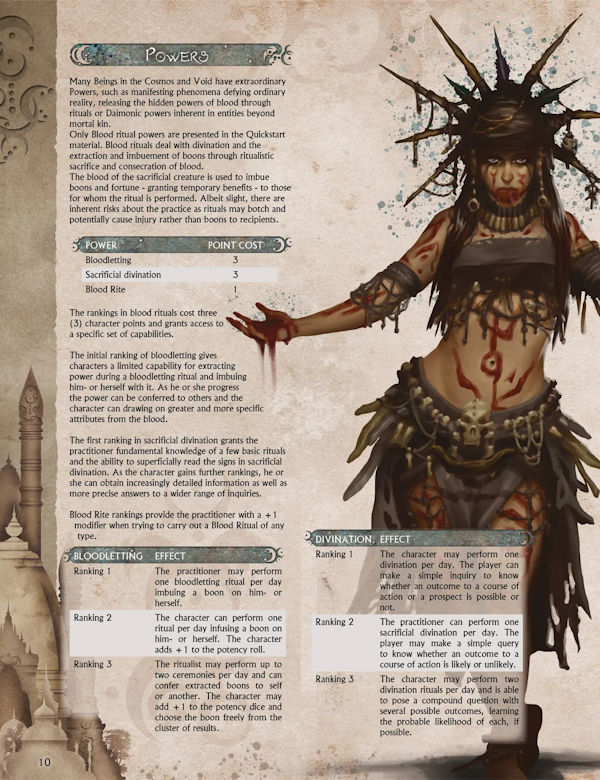 First, we have Blood Rituals, a form of magic very reminiscent of the ancient real-world cultures Black Void draws inspiration from. It has two paths: Bloodletting and Sacrificial Divination. Practitioners of Bloodletting can learn to ritually sacrifice a creature and grant themselves (or at higher levels, someone else), a random boon such as a Skill or Trait bonus or a temporary Talent like the ability to ignore pain. The higher their Blood Rituals ability the more rituals they can perform in a day and the better chance they have of getting a more powerful result.
First, we have Blood Rituals, a form of magic very reminiscent of the ancient real-world cultures Black Void draws inspiration from. It has two paths: Bloodletting and Sacrificial Divination. Practitioners of Bloodletting can learn to ritually sacrifice a creature and grant themselves (or at higher levels, someone else), a random boon such as a Skill or Trait bonus or a temporary Talent like the ability to ignore pain. The higher their Blood Rituals ability the more rituals they can perform in a day and the better chance they have of getting a more powerful result.
Crucially, novice practitioners have to take whatever boon they roll and like it, while more experienced practitioners have greater control over which boon to grant. I like that as a method of demonstrating skill in magic without just piling on raw power. It creates a sense of dealing with unknown and terrible forces your character will slowly begin to grasp, if they survive for long enough.
The art of Sacrificial Divination is a method of learning the future by reading the sacrifice’s entrails (an ancient real-world practice called haruspexy). Higher Ranks in Sacrificial Divination let the player ask more complex questions. Dealing with divination is always tricky in RPGs but Black Void does a pretty good job with some decent examples provided for context.
Both forms of Blood Ritual benefit from the same Blood Rituals Skill and from more powerful sacrifices. Animal sacrifices are fine, but you can get a lot more power from killing a sentient or magical creature. This opens up some interesting, though grisly, story options, particularly for inexperienced characters who want to wield occult power beyond their usual means.
Blood potency is calculated by totalling the point values of a creature’s Traits, Talents, Attributes, Powers and Enlightenment.
There is, of course, a backlash table for failures on Bloodletting or Divination rolls. With such fun consequences as nausea, weakness, spontaneous phobias and awful cosmic revelations. Overall, this is a nasty form of magic but very evocative of the game’s harsh and primal setting.
Mysticism cleaves closer to traditional fantasy magic; it allows practitioners to focus their will to manipulate the world around them. Mysticism is broken into five Spheres, each of which must be learned separately. They are Forces, Life, Matter, Mind and Void.
- Forces covers gravity, fire, light and kinetic energy—allowing effects like telekinesis and the ability to increase or reduce light or heat.
- Life covers healing, enforced mutation and bodily harm. (An interesting combination.)
- Matter lets the Mystic shape, strengthen or weaken physical objects. Even allowing the transformation of lead into gold at higher levels.
- Mind covers the classic range of psychic powers like illusions and mental commands.
- Void grants abilities similar to Enlightenment—sensing, navigating and manipulating the Void. It also allows a Mystic to dispel effects created by others. To get a full understanding of its different effects, you’ll have to flip to the Enlightenment section and read through the list of power descriptions there, which is annoying.
There are no spell lists as such. Players simply describe what they want to do and calculate the difficulty, based on the tables provided. (Though the writers admit there’s no way to cover all possible uses of Mysticism.) Range, casting time, and the raw power of the effect all factor in. Players can, however, pay points to learn a particular casting by rote and get bonuses to the roll to cast it.
There are two types of Mystic—Furores and Gnostics.
Furores control magic through the raw power of their will, channelling their emotions into the casting. As a rule, they can unleash more powerful effects than Gnostics. Gnostics use careful study, rituals and meditation to control magic. They are less likely to suffer Calamities from botched castings than Furores are.
The Calamities table (rolled on if you spectacularly fail a Mysticism roll), has dozens of possible outcomes. Ranging from a chill running down the Mystic’s spine, to howling abysmal winds swirling around their briefly paralysed body and ultimately to a creature reaching out of the Void and dragging the character, kicking and screaming, into oblivion.
Mysticism is certainly a system that has great potential for building all sorts of effects and harnessing player creativity. It will take some time to get used to though, I wouldn’t recommend it for novice players or anyone who shies away from a bit of maths in their games.
Arbiter Section
Skipping over a short chapter on Advancement, we move to the GM Advice section. Here we get an idea of what the writers actually intended the game to do. Which is basically to allow gaming groups to play in whatever genre or genres they like and even blend them or switch between them from session to session. Noir mysteries, cosmic horrors, exploration, war stories, social manoeuvring, Black Void can do it all, we’re told. And given the level of detail that’s put into the setting and individual sections of the rules, I can believe it.
We do get some themes to help guide the direction of a campaign. The search for a new home. The question of what humanity actually is (loved this one, as it’s key to my own homebrew setting). The great unknown universe awaiting your exploration. The historical era the game is intended to evoke.
A significant focus for this setting are the cultures of Mesopotamia. This includes Babylonian, Assyrian, Hittite and Akkadian cultures, who often interacted with ancient Egypt due to proximity.
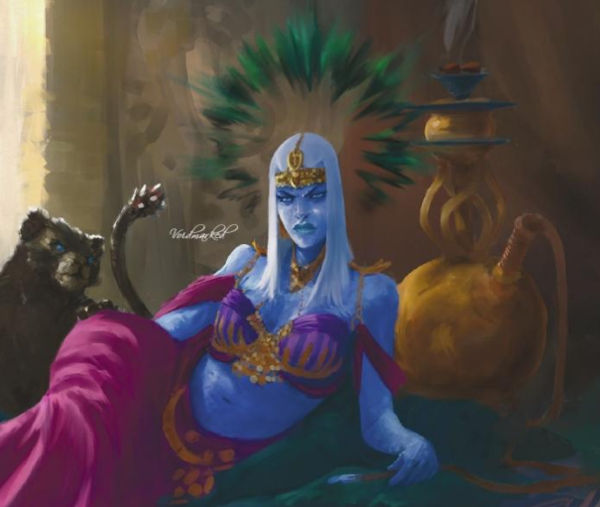
We also get a few nice points for new GMs to bear in mind—take cues from your players, don’t shoot down their ideas, be subtle when characterising your NPCs. And there’s more detail on social encounters, combat encounters, creating NPCs and so on. New GMs will find a lot of help in this section. There’s even some advice on providing interesting rewards to your players e.g. custom weapons, cultural items, esoteric objects, puzzles—a really nice touch.
I also liked the suggestion that encountered creatures should know a number of combat manoeuvres based on their Intellect score. There are a few more setting goodies too, like magical tattoos and grafted limbs. (Don’t ask where the limbs come from.)
Most intriguingly, we get more detail on the Void—an endless dark storm of unreality without air or direction but still navigable through following subtle currents. While travelling this “endless oblivion” you could be mutated, attacked by its strange denizens or stranded on a strange and unknown world. A key part of the setting is the fact that the Void often bleeds through into the Cosmos. A whole set of rules and tables is dedicated to tracking these ruptures in the Veil and documenting their many awful effects.
Llyhn
It’s quite possible to base an entire campaign in Llyhn itself, without ever traversing the Void or visiting other worlds. So, Llyhn gets a lot of detail. I won’t go through each district as this review is long enough already. Let’s just look over a few highlights.
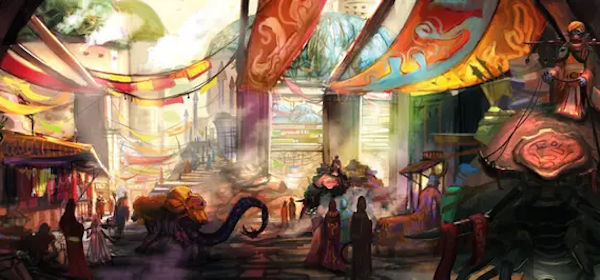
- The complex network of wards and chambers that make up the Morning Palace; where the secretive and amoral Unseen Rulers of Llyhn dwell, alongside the masked and imposing figures of their Jinassar guards.
- The waterlogged mud flats of Dhaarese; with its wooden platforms at different levels, its teeming guild halls and its Midnight Market, which is tucked away on a low platform out of sight of the authorities.
- The many competing and zealous sects that swarm through the temple district of Pai’Karaan. Be wary of your conduct when passing through here, lest you unwittingly break some religious taboo and suffer punishment at the hands of the righteous.
- The vast tent city out on the Barrens, where a gathering of human nomads has spontaneously invented a form of democracy and now seeks to help others where they can. These people are clearly the ‘good guys’ of the setting.
- The sacred river, reminiscent of the Ganges. And yet unlike it, because in the sacred basins of the Margidda River, religion can literally become red in tooth and claw.
As a consequence of the cleansing rituals, it is not uncommon that silt sharks grab a believer who has ventured out too far in his zealousness—and as another screaming and thrashing martyr is professed the surrounding crowds sing praises in holy ecstasy at the bloody spectacle.
Other sights include a shroud-covered rock inscribed with litanies that are said to be capable of ending the universe, an eerie jungle graveyard and an ancient fisherman catching imaginary fish, encouraged by his large, alien companion (who seems quite cheerful, despite being partially pinned beneath a fallen pillar).
Each District comes complete with significant NPCs, rumours and plot hooks to get you started. Human enclaves being attacked, aristocratic intrigue in perfumed corridors of the Palace of Sighs, unfair taxes, a turf war between rival cults, slaves in need of rescue, a mission to find a particular blood ritualist and supply her with a live specimen from a dangerous species of alien predators. Not all of these plot seeds set my world on fire, I must admit, but it never hurts to throw them in. And there are enough gangs, cults, odd merchants, master criminals and vicious nobles in Llyhn for most GMs to be able to string together their own adventures without much trouble.
I did like the Unseen Rulers—mysterious beings that seem interested only in profit and trade and are otherwise happy to let the citizens of Llyhn do whatever they wish. Though if you cut into their margins you’ll be targeted by their elite private army or even the dreaded Hohr’loh’kin.
Floating about the city swathed in bands inscribed with obscure litanies in an unknown script, and strange scarlet armour and helmets seemingly latticework covering nothing but dark depths, the Hohr’loh’kin are mystics and warriors commanding powers rivalling even the Anunnaki.
If you and your players like eldritch secrets then you could spend an entire campaign uncovering the true nature of the Unseen Rulers and their servants.
My overall impression of Llyhn as a setting is it’s stuffed full of intrigue and originality, with flashes of really wonderful weirdness to enjoy. Personally, I would have preferred more weirdness and less information on taxes and trade goods. But for those who are used to more traditional fantasy settings, this fairly grounded approach may be just what they’re after.
Factions and People
This section details philosophical, religious and miscellaneous factions of Llyhn. Again, a lot of thought has gone into making these factions unique and you could spend a whole campaign getting to grips with a particular cult or philosophy, if you were so inclined.
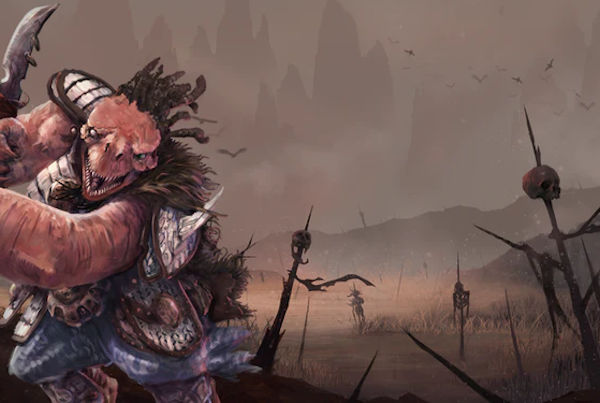
There are the Arammu, who believe “Everyone is equal before the great wheel of life.” More specifically they focus on what can be comprehended by the senses—life, sensation, comfort and happiness for all. Abstract ideas are pointless and probably unreal.
The Karmic Circle believe all actions, good or bad, will ultimately receive their just reward, in this life or the next. Some use this to justify a privileged birth as the fruit of a virtuous past life. Others warn those adherents of the karmic perils that bad behaviour will earn them. Though since no two groups of Karmics can agree on what good and bad actions are, achieving a better future life is not as simple as it might sound.
The group that stuck with me were the Ragged Catharsis. They take the dead and dying to their temples and prepare them for the afterlife with mysterious and brutal cleansing rituals. They do this with or without permission from the friends and family of the deceased. It’s very easy to come up with plot seeds based around that, while some of the other factions might take more work to bring into an adventure in a meaningful way.
The chapter ends with a list of notable NPCs. A cast of legendary wanderers, honourable mercenaries, helpful mystics, fake princes, information brokers, human-hating aliens and an exiled empress. There are some great character pictures, particularly The Red King and Sho’ Gu Rén Mer.
Guided by nothing but the stelliferous night sky and intuition he wanders from one place to another, seeking bulwarks of civilisation albeit avoiding contact with strangers as if what he seeks is never among who he meets.
I could see uses for most of these characters in spinning a story in Llyhn, as antagonists, allies or patrons. And I liked the particular role an NPC might play depends very much on the Player Characters’ own activities and morality.
Species
A stand-out chapter. This details dozens of unique alien species, many of them sentient beings with their own cultures. Each of the sentient races comes with a nice, full-colour portrait and details of their behaviour, society, lifecycle, diet, status in Llyhn and the sort of encounters Player Characters might have with them.
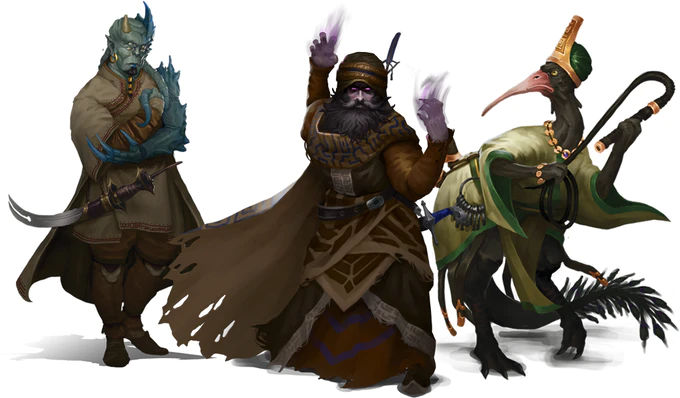
In a sharp contrast to the standard fantasy offerings of elves, dwarves and halflings, every sentient species in this section has a very different physical appearance and societal outlook. There’s the giant, horned, near-spherical Harith, who have six arms and move around on a nest of tentacles. The long-beaked, bird-like Ka’Alum who have a, not entirely unearned, reputation as slavers. The grungy, burly, thick-snouted Naqasti who make up a large proportion of Llyhn’s population but appear to lack the ambition to do more than work as labourers. The Qhu—flying molluscs with long whip-like tentacles they use for fighting and manipulation, their behaviour and emotional reactions are quite inexplicable to just about every other species in the Cosmos. One great touch is a discussion of each species’ reactions to combat, the tactics they would use and even their preferred combat manoeuvres.
We also get some intriguing mysteries to ponder. Why did the Je’Ehl—self-styled noble bringers of enlightenment, chose to scorch the Harith homeworld to ashes and dust? And perhaps more importantly, how did they manage to achieve such an appalling feat of destruction in a setting that hasn’t even discovered gunpowder?
Moving on to Esoteric species. This sub-section draws heavily from ancient Mesopotamian, Hindu and Islamic mythologies, with some truly alien wild cards thrown in for good measure.
There are the noble Deva and their savage and sensual counterparts, the Asura. The capricious Djinn, who you may well recognise. And the Lamassu—mighty and imposing winged bulls with humanoid heads and a surprisingly kindly nature, who might be less familiar.
Most formidable of them all, are the Anunnaki. These godlike creatures possess vast magical powers and can inspire Fear, Delirium or Awe at will. Each one is unique in its appearance and motivations. Unlike the gods in most fantasy settings, the Annunaki wander the worlds in search of worshippers, territory or more ephemeral rewards.
Honourable mention should go to the Varin, best described as turquoise, five-eyed, sensualist, space-mermaids.
One odd thing to mention before we move on. The Annunaki, Deva and Asura shown in the artwork all have somewhat human features. (Though Anunnaki are described as having a great range of features between individuals.) Humans are supposed to be little more than a footnote in Black Void’s setting, so it’s strange these godlike beings would resemble them. I’d have expected a more alien aspect to their artwork or at least a note explaining that they appear different to different onlookers.
(Alternatively: If beings as powerful as the Anunnaki do resemble humans, this would seem to be a perfect plot hook. Surely there would be other beings seeking to learn more about humans and their supposed divine connections? And surely human groups could attempt to parlay this resemblance into some form of influence?)
There’s also a smallish but varied bestiary of non-sentient beasts. Ranging from beaked snakes to things that resemble no terrestrial species I’ve ever seen or imagined. Manticores get a mention under the name Mardkhora and are graced with a wickedly sleek and vicious portrait. Most interesting of all are the blind, scaly, beaked predators that have a rapacious appetite for slaughter but never eat their victims, the book speculates these creatures are the leftover guardians of a lost civilisation.
And finally, we get to the weirdest subsection of this weirdest of chapters in a book of esoteric fantasy—the inhabitants of the Void. Which includes:
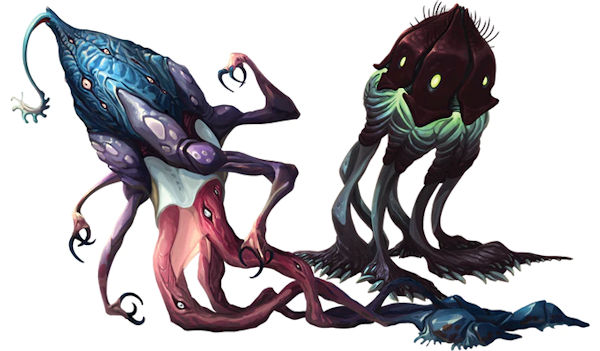
- Deep Devourers—sort of like sharks, if sharks had more eyes, limbs and claws than a family of bears. And were amorphous and partially insubstantial. And lived in space.
- Madarchs—shoals of fungal jellyfish creatures that use spores to warp the environment around them, mutating and maddening the local flora and fauna in the process. (If you’ve read The Colour Out of Space or seen the film, you’ll get the idea.)
- Yiagh’Zii—In the writers’ own words, they are, “a species of Void entities known to dance on pernicious peaks in demented rapture to please their indefinite masters from the deep oblivion.” Also, if they meet anyone with an interesting mind, they use their psychic tongues to eat the mind, or drag the unfortunate victim away to be drained of sentience in a crazed ritual, the true nature of which is impossible for human minds to grasp.
Great chapter, 9 out of 10, would read again.
Worlds
The final chapter takes us beyond Llyhn to the worlds inhabited by the various alien species mentioned in the previous chapter. True to form, the book is set out in a methodical and detailed fashion. Each world is described in terms of environment, notable species, culture, trade, topography, and prominent areas. Gravity, aridity and levels of unreality also get a mention. And because the authors always think things through, each world comes with reasons to travel there and ways to make a profit once you arrive.
- Capture a giant bird.
- Set up a mining deal.
- Plan a daring escape attempt for slaves stuck on a world where the thin atmosphere is killing them.
- Engage in espionage on behalf of an alien empire.
- Search a steaming jungle for a stela that may hold a clue to the fate of lost Earth.
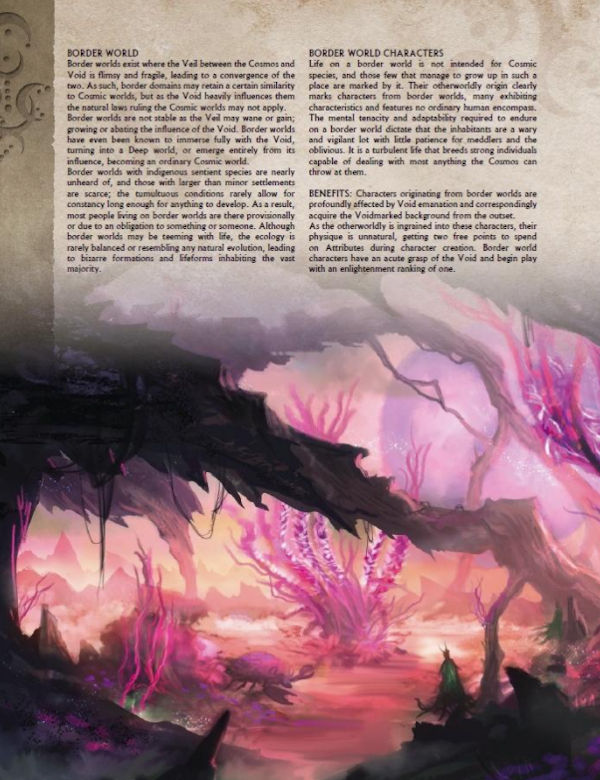 One particularly interesting world is actually three planets in close orbit around each other. To the point that the males of the dominant sentient species can actually fly between them. I love the creativity on show here. More fantasy settings should draw on sci-fi themes like this for inspiration.
One particularly interesting world is actually three planets in close orbit around each other. To the point that the males of the dominant sentient species can actually fly between them. I love the creativity on show here. More fantasy settings should draw on sci-fi themes like this for inspiration.
Another world has a barren surface that hides a vast complex of underground caves. There, beneath the earth, a hardy race of small creatures scrapes a living amongst luminous fungi and grubs. Visitors have little to fear from the locals but must be wary of the flash floods that sometimes tear through the tunnels.
Then there’s the swampy death-world full of toxic gas vents and rampaging bacteria that will viciously infect even the slightest wound.
There’s certainly enough here to get you started with a Cosmos-spanning campaign of exploration. And I could see myself building new worlds by following the classification system used earlier in the book and throwing together new sentient species by combining different Attributes, Talents and Flaws.
Final Thoughts
Black Void is a vast and sprawling game that falls over itself in an attempt to give you more and more options. Five different GMs could read through it and end up creating five completely different campaigns. It’s both a strength and a weakness. I can pretty much guarantee any fan of RPGs or SFF fiction will find something in this book to love. If you appreciate games like Mage: The Awakening, you’ll enjoy the flexible magic system. If you prefer the swashbuckling adventures of 7th Sea or Conan, you’ll like the combat system with its many different manoeuvres and table of cinematic perils. If the cosmic horror, which features in the ever-growing legion of Cthulhu Mythos games, is more your bag, the various forms of madness, delirium and unknowable terrors on offer will tempt your jaded and deranged palate.
But you’ll likely have to wade through some stuff that doesn’t catch your interest to get to the bits you want. And you may find yourself struggling to work out exactly where to start or what to do with the setting. The writers are aware of the importance of plot hooks and story seeds to get GMs and players interested and have spread them through the book with reasonable frequency. Although (and I feel rude for asking for more content from such a large book), a starting adventure might have been helpful, if only as a way to ease players and GMs into the setting.
The rules are serviceable. They mostly revolve around the core mechanic, which isn’t hard to get the hang of. The devil is in the details though—all the subsystems and tables for different situations. Having read through the game once I wouldn’t feel qualified to run a one-shot with it unless I had the rules at hand ready for any combat, magic or madness that might ensue. If you do get the hang of the rules, they should work well enough for most any situation you throw at them. Because if you think of something, the authors probably already thought of it and have made a note about it somewhere. Honestly, you could rip the rules system out and use it to run all sorts of other fantasy settings if you wanted to.
Between them, the rules and the setting of Black Void could sustain years of play for the right GM and the right group.
Another reason to like the book is the illustrations. I’m a sucker for good artwork and the pictures in Black Void are lush and plentiful. Beautifully dressed alien beings, bright silks and curved swords give an Arabian Nights feel with sci-fi overtones. The vivid hues of weird, composite creatures pop off the page. Heavily tattooed or painted warriors and turbaned mystics showcase cultures that aren’t often placed front and centre in roleplaying games. Vast and eldritch beings lurk in the gloom, waiting to pounce. Grand vistas open up before your wondering eyes—stepped pyramids, dusty plains dotted with chimneys of wind-sculpted rock, crimson jungles and ash-covered valleys. Any remaining blank space is taken up with sketches of characters of all sorts of species.
Weighing in at £20 for a 400+ page PDF, Black Void provides good value for money, particularly as this is the only book you need to run the game. There’s a lot to get your teeth into and some nice ideas to mine for your own setting if you choose not to use the game as written. And it has that sheer, blazing uniqueness which I always look for in an RPG—you’re never going to find another mashup of Planescape, Stargate, Arabian Nights, ancient Mesopotamia, and Call of Cthulhu.
If you like some sci-fi and horror in your fantasy, if you like originality and weirdness in your settings, if you appreciate having a ton of options to use to build your own gaming experience, if you can cope with some numbers and complexity in your games of make-believe; this could be the book for you.


Looks like we missed out the disclaimer here.
To confirm, I received a free digital review copy of this book in return for an honest review.
Also, I recently discovered that a full length adventure for Black Void is available for free on Drivethrurpg! I did not have time to review it but it may well address my concerns about where a gaming group would start with this game. It’s called The Flight From Salvation Square.
Wow. This is a very well done review. I really appreciate all your hard work. So often reviews are quite shallow and offer little insight. It is clear you really dig in to the book. If someone asked me about Black Void I would send them a link to this review.
Thank you!